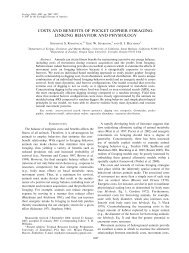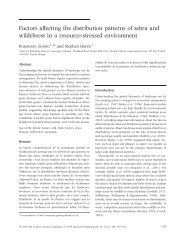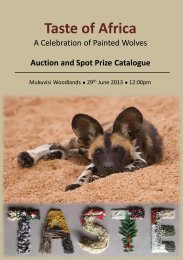136 W. A. TAYLOR ET AL.Materials and methodsStudy site<strong>The</strong> study was carried out at Tussen die Riviere Nature Reserve (TdR) (30330S,26307E) in <strong>the</strong> Eastern Mixed Nama Karoo (H<strong>of</strong>fman, 1996), part <strong>of</strong> <strong>the</strong> NamaKaroo Biome, between June 1996 and December 1998. With a total area <strong>of</strong> 22,000 ha,TdR has an average annual rainfall <strong>of</strong> 400 mm falling mostly in summer (Nov.}Mar.).Summer temperatures exceed 303C, while in winter (May}Jul.) temperatures <strong>of</strong>tendecline below 03C at night.<strong>The</strong> vegetation <strong>of</strong> TdR comprises three major communities (Werger, 1973):(1) Riverine communities. Mostly made up <strong>of</strong> <strong>the</strong> Acacia karoo–Celtis africanacommunity on <strong>the</strong> levees <strong>of</strong> fine alluvial sand. Usually three-layered consisting <strong>of</strong>a tree layer, an open 2–4-m tall shrub layer, and a field layer up to 0)6 m consisting<strong>of</strong> grasses, herbs and small shrubs.(2) Communities <strong>of</strong> <strong>the</strong> flats and gently sloping grassland. <strong>The</strong>se are usually twolayered,with <strong>the</strong> most important being <strong>the</strong> grass and dwarf shrub layer between0)15 and 0)6m high.(3) <strong>The</strong> communities <strong>of</strong> <strong>the</strong> steep slopes. This is <strong>the</strong> richest community bothfloristically and structurally, consisting <strong>of</strong> three or four layers. <strong>The</strong>se are: a sparselayer <strong>of</strong> creeping and rosette plants up to 0)05 m; a grass and small shrub layer upto 0)8 m; a tall shrub layer between 1 and 4m; and sometimes an open tree layerup to 6 m high.Study animalsOne <strong>of</strong> <strong>the</strong> aims <strong>of</strong> <strong>the</strong> study was to habituate <strong>aardvark</strong>s in order to make <strong>feeding</strong>observations. To achieve this, <strong>aardvark</strong>s were radio tagged to enable location andfollowing at night. Thirteen <strong>aardvark</strong>s were captured in cage traps set outside burrowentrances and immobilised using a combination <strong>of</strong> ketamine hydrochloride (Anaket-V,Centaur, Bayer A.H., Isando), medetomidine hydrochloride (Domitor, Novartis A.H.,Isando) and halothane (Fluothane, Zeneca) (Nel et al., 2000). Telonics radio transmitterswere implanted intra-abdominally (Telonics, Telemetry-Electronic Consultants,932 E. Impala Avenue, Mesa Arizona 85204-6699). Four <strong>aardvark</strong>s were habituated(two in 1996 and two in 1998) by following <strong>the</strong>m on foot for periods <strong>of</strong> 3 h every night.This process took up to 3 months for each animal. Once tame, <strong>the</strong>se <strong>aardvark</strong>s could beapproached at any time and observed from a distance <strong>of</strong> 1m. Nine <strong>aardvark</strong>s remainedunhabituated despite months <strong>of</strong> attempted following. Telemetry also enabled <strong>the</strong> determination<strong>of</strong> home ranges, which made it possible to identify <strong>the</strong> source <strong>of</strong> faeces fromunhabituated <strong>aardvark</strong>s.Faecal analysis<strong>The</strong> heads <strong>of</strong> adult ants and termites remain intact while passing through <strong>the</strong> <strong>aardvark</strong>GIT and can be extracted and identified from faeces. Generally faecal analysis only givesan approximate indication <strong>of</strong> dietary composition. Differential digestibility <strong>of</strong> differentfood stuffs results in absolute proportions <strong>of</strong> residues in <strong>the</strong> faeces which maydiffer from <strong>the</strong> proportions in which <strong>the</strong> food stuffs were ingested (Putman,1984). Few foods have constant digestibility, as is <strong>the</strong> case with <strong>the</strong> insect exoskeletonwhich varies between taxa and between developmental stages. Adult ants and termites,however, have a strong cuticle which is sclerotised on <strong>the</strong> head (Rockstein, 1978).
FEEDING ECOLOGY OF THE AARDVARK 137During faecal analysis <strong>the</strong>re was never any evidence <strong>of</strong> partial digestion <strong>of</strong> <strong>the</strong> heads <strong>of</strong>adult prey species, so it was assumed that differential digestion did not occur within<strong>the</strong> heads <strong>of</strong> adults.This assumption was not made for developmental stages. <strong>The</strong> outer coats <strong>of</strong> insecteggs do not generally contain chitin (Hinton, 1981), while larvae have a s<strong>of</strong>t, easilyruptured chitinous integument. Pupae were <strong>the</strong> only developmental stages <strong>of</strong> ants topass through in <strong>the</strong> faeces. Production <strong>of</strong> pupae coincides with that <strong>of</strong> eggs and larvae(Steyn, 1954), so <strong>the</strong> latter were possibly eaten but not detected in <strong>the</strong> analysis.Developmental stages were not included in <strong>the</strong> results.<strong>The</strong> number and composition <strong>of</strong> <strong>aardvark</strong>s available for faecal collection variedthroughout <strong>the</strong> study due to <strong>the</strong> capture <strong>of</strong> more animals or losses via transmitter failureand death. From June 1996 to December 1997, faecal samples were collected monthly.In 1998, faeces were collected in two distinct seasonal periods, May–Jul. (winter), andOct.–Dec. (summer). All faeces collected were fresh.In 1997, six faecal samples were collected every month from each <strong>of</strong> <strong>the</strong> twohabituated <strong>aardvark</strong>s while <strong>the</strong>y were being followed, and a total <strong>of</strong> 10 faecal samples permonth were collected from unhabituated <strong>aardvark</strong>s. <strong>The</strong> latter comprised radio-implantedindividuals as well as unknown animals in separate areas <strong>of</strong> <strong>the</strong> Reserve.Experience <strong>of</strong> <strong>aardvark</strong> behaviour gained from tracking was utilized to ensure that faeceswere assigned to <strong>the</strong> correct animals. Although <strong>the</strong> number <strong>of</strong> <strong>aardvark</strong>s available varied,faeces were collected from an average <strong>of</strong> six animals per month.In 1998 10 faecal samples were collected from each <strong>of</strong> <strong>the</strong> four habituated <strong>aardvark</strong>s inboth winter and summer. Ten faecal samples from different <strong>aardvark</strong>s were alsocollected.Aardvark faecal deposits normally comprised 20–50 small ovoid pellets with a drymass <strong>of</strong> up to 300 g. To represent <strong>the</strong> contents <strong>of</strong> one faecal deposit, one sub-sample <strong>of</strong>20 g dry mass was collected from different parts <strong>of</strong> <strong>the</strong> deposit. After soaking inwater <strong>the</strong> pellets were carefully broken up with a pestle in a mortar, following Willis et al.(1992). This freed organic material from <strong>the</strong> soil, allowing it to float to <strong>the</strong> surface to befiltered <strong>of</strong>f and dried. Fresh water was added to <strong>the</strong> sample several times to extractas much <strong>of</strong> <strong>the</strong> organic material as possible. A larger faecal mass was unnecessarybecause it had been found previously that 15 g were sufficient to accurately representan entire faecal deposit (Daniels, 1984). This was confirmed during <strong>the</strong> presentstudy (pers. obs.).Once dry, all individual ant and termite heads were extracted. Species identificationwas made from heads because <strong>the</strong>y retained <strong>the</strong>ir shape and colour, allowing comparisonwith reference specimens. During sorting, morphologically distinct termite castes werecategorised into soldiers and workers. Two ant genera were not separated into speciesdue to <strong>the</strong> difficulty in distinguishing <strong>the</strong>ir heads; <strong>the</strong>se were Anoplolepis spp.(comprising A. custodiens and A. steingroeveri) and Camponotus spp.For each faecal sample <strong>the</strong> frequency <strong>of</strong> occurrence <strong>of</strong> every prey species wasconverted into a percentage occurrence, <strong>the</strong>n monthly or seasonal averages estimated foreach <strong>aardvark</strong>. Aardvark averages were <strong>the</strong>n clumped with o<strong>the</strong>r <strong>aardvark</strong>s by month orseason.Feeding observationsHabituated <strong>aardvark</strong>s were observed from a distance <strong>of</strong> 1m while <strong>the</strong>y foraged. Observationperiods lasted two hours and started at different times <strong>of</strong> <strong>the</strong> night. In 1997 two<strong>aardvark</strong>s (1 m, 1 f ) were observed every month for total periods <strong>of</strong> 153 h and 173h each, with <strong>the</strong> time spread fairly evenly between months. In 1998, each <strong>of</strong> <strong>the</strong> fourhabituated <strong>aardvark</strong>s (2 m, 2 f ) were observed for an average <strong>of</strong> 32 h per season (winter:May–Jul.; summer: Oct.–Dec.), with a grand total <strong>of</strong> 256 h observation.





